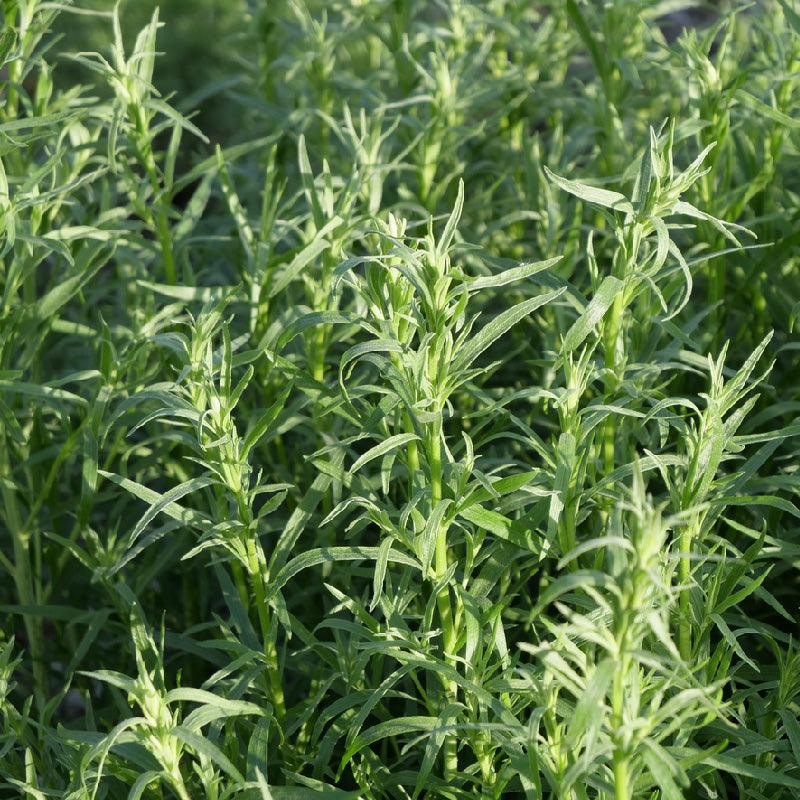Item Number: PV204
Organic French Tarragon (1 Gallon)
Elevate Culinary Creations
USDA hardiness zones: 4 - 9
(Artemisia dracunculus var. sativa) stands as an aromatic perennial herb prized for its robust flavor and culinary applications. Recognized for its lance-shaped, glossy dark green leaves, it reaches a stature of 2 to 3 feet (60 to 90 cm). These leaves emanate a distinct anise or licorice-like fragrance, intensifying upon utilization in fresh or dried states.
Prominent in French cuisine, French Tarragon embellishes a diverse spectrum of dishes, from sauces and salads to egg-based recipes, effortlessly harmonizing with poultry, fish, and vegetables. Propagation is commonly achieved via stem cuttings or division, as viable seeds are rarely produced.
Thriving in well-drained soil and basking in sunlight, French Tarragon boasts culinary significance grounded in centuries of tradition. Its versatile application and potent aroma position it as a revered herb in both professional kitchens and home gardens, contributing an essence of refinement to various culinary creations.
The Certified Organic 1-gallon French Tarragon endorses its culinary prowess, enabling enthusiasts to cultivate this aromatic treasure with ease.
French tarragon is a versatile herb renowned for its delicate flavor and aromatic qualities, making it a prized addition to culinary creations. While fresh tarragon is often preferred for its vibrant taste, drying tarragon is a convenient way to preserve its flavor for later use. When harvesting fresh herbs like tarragon, it's essential to consider the health of the root zone to ensure continued plant growth and vitality. By providing well-drained soil and proper watering, you can support robust root development and promote healthy plant growth. Whether enjoyed fresh or dried, French tarragon adds a delightful touch to salads, sauces, and other culinary dishes, infusing them with its unique flavor profile and enhancing their overall appeal.
French tarragon, scientifically known as Artemisia dracunculus var. sativa, is a popular culinary herb prized for its aromatic leaves and distinctive flavor. Here's a comprehensive guide on how to successfully grow French tarragon:
Plant Selection: When choosing French tarragon plants, look for healthy specimens with vibrant green foliage and strong stems. It's best to obtain plants from reputable nurseries or garden centers to ensure quality and authenticity.
Growing Conditions: French tarragon thrives in well-drained soil with a pH level between 6.5 and 7.5. Plant it in a sunny location with at least six hours of sunlight per day, although it can tolerate partial shade in hotter climates. Ensure good air circulation around the plants to prevent moisture-related diseases.
Planting: Plant French tarragon in the spring after the last frost date in your area. Dig a hole slightly larger than the root ball and place the plant at the same depth as it was in the container. Space plants 18 to 24 inches apart to allow for adequate airflow and growth.
Watering: Keep the soil consistently moist but not waterlogged, especially during the plant's establishment period. Water deeply once or twice a week, depending on weather conditions and soil moisture levels. Avoid overhead watering to prevent fungal diseases and water the soil directly at the base of the plant.
Fertilization: French tarragon is not heavy feeder and typically does not require much fertilization. However, applying a balanced fertilizer or organic compost in the spring can help promote healthy growth and foliage development. Avoid over-fertilizing, as excessive nitrogen can lead to weak growth and reduced flavor.
Pruning and Harvesting: Regular pruning helps promote bushy growth and encourages the production of flavorful leaves. Pinch back the tips of the stems throughout the growing season to encourage branching. Harvest French tarragon leaves as needed by snipping them with scissors or pruning shears, taking care not to remove more than one-third of the plant at a time.
Pest and Disease Management: French tarragon is relatively resistant to pests and diseases, but occasional problems may arise. Keep an eye out for aphids, spider mites, and powdery mildew, and take appropriate measures to control them if necessary. Neem oil or insecticidal soap can be effective against pests, while proper spacing and good airflow can help prevent fungal diseases.
Overwintering: In colder climates, French tarragon may die back to the ground in the winter. Mulch around the base of the plant with straw or leaves to protect the roots from freezing temperatures. Alternatively, you can bring potted plants indoors during the winter months to protect them from frost.
Propagation: French tarragon is typically propagated by division rather than from seeds, as the seeds are often sterile or produce plants with inferior flavor. Divide established plants every few years in the spring or fall to rejuvenate them and increase your stock of plants.
Culinary Uses: French tarragon is a staple herb in French cuisine, prized for its intense flavor and aroma. It pairs well with fish, poultry, eggs, vegetables, and sauces, adding a subtle anise-like flavor to dishes. Use fresh leaves to flavor salads, dressings, and marinades, or add them to cooked dishes just before serving for maximum flavor.
Growing French tarragon can be a rewarding experience for gardeners and culinary enthusiasts alike. With the right growing conditions and care, you can enjoy a bountiful harvest of flavorful leaves to enhance your favorite dishes and add a touch of French flair to your culinary creations.
Visit our Berry, Vine & Crowns Characteristics Chart to compare growing characteristics for all our berries, vines, and crowns.



Check Your Zone Compatibility:
Compatible with your zone.
Growing Zone for

Our Guarantee To You
Since 1976, we've served our customers at every stage of growing. Please contact us at any time. We are happy to support and assist you.
Shipping Information
Shipping Information
Shipping Weight: 5.0 lb
Features
Features
- Container Compatible
- Long-Lived
- Potted
Characteristics
Characteristics
Planting & Care
Planting & Care
Useful Information
Useful Information
Guarantee
Guarantee
We guarantee the perishable items we sell to be in good, viable condition when we sell them. Perishable items include, but are not limited to, garlic bulbs, flower bulbs, seed potatoes, onion sets & transplants, potted or bare root trees, vegetable crowns, etc. If your perishable item arrives in substandard condition, take photographs and please contact us within 3 days of the purchase date (or delivery date) and we will provide you with a refund of the purchase price (excluding shipping costs), or a replacement. Accordingly, we urge you to open any boxes marked as ""Perishable"" immediately upon receiving them and inspect the shipment thoroughly (do not crack open heads of garlic, we do not accept claims on cracked garlic). Because some perishable items can deteriorate very quickly, we cannot accept any claims beyond the 3-day time frame as it becomes too difficult to determine if these items were delivered in substandard condition, or if they turned into such substandard condition because of having been improperly cared for or stored once delivered.
Share



Healthy plant. Good Size. Number of Stalks. Happy with it.









